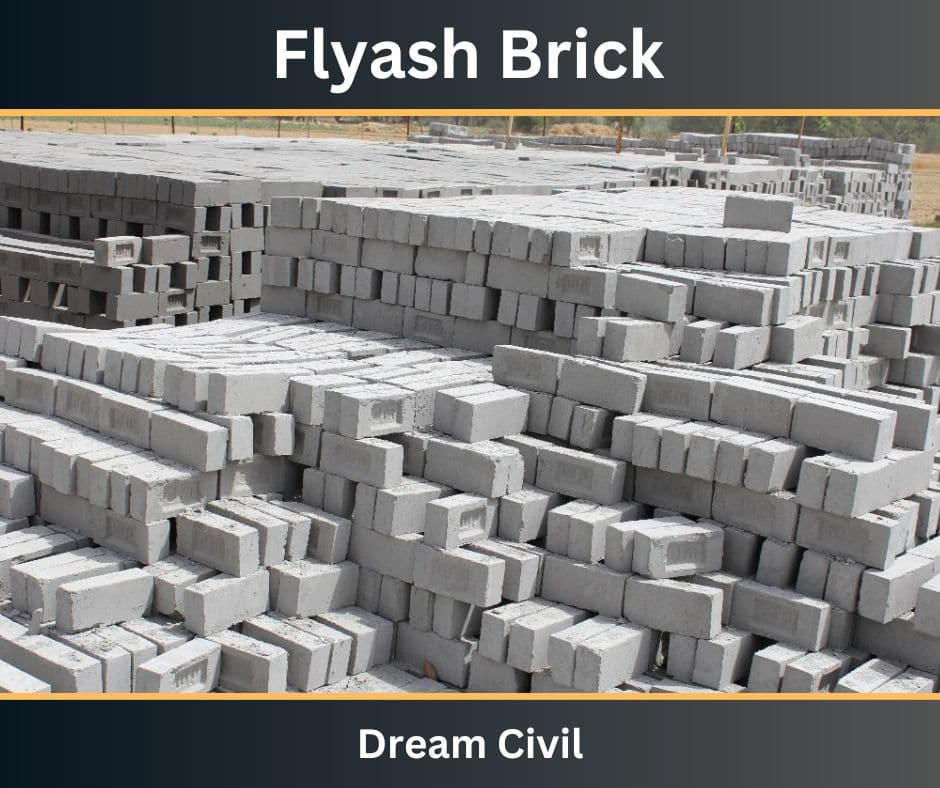Table of Contents
Fly Ash Bricks is a building material prepared by utilizing class C or class F fly ash and water.
Fly ash is a result of coal-fired power plants that are repeatedly utilized as an admixture in concrete to substitute a portion of Portland cement.
Fly ash bricks are utilized as an alternative to regular clay bricks and have more useful properties than clay bricks.
Fly ash bricks are competitive in comparison to normal clay bricks and provide enormous indirect benefits.
The utilization of fly ash bricks outcome in the conservation of natural resources as well as the prevention of the environment.
1. Composition of Fly Ash Bricks
The important compositions of fly ash bricks are:
a. Fly ash
b. Cement
c. Sand
d. Water
In India, 72% of power plants are coal-based. These power stations produce about 40 million tonnes of fly ash yearly.
Fly ash includes Co2 ejected from thermal power plants, and industries utilizing coal as fuel radiate undesirable ash and smoke from which fly ash is made.
In entire power plants and industries, they divide the fly ash by utilizing the cyclone converter. This fly ash is then utilized as a raw material for the manufacture of bricks.

2. Manufacturer of Fly Ash Bricks
The process of manufacturing Ash bricks is as follows:
1. Mixing Fly ash with cement, sand & water.
2. Pouring mortar into the mold.
3. Drying in Atmospheric temperature & pressure.
4. Curing for 28 days.
5. Removing from the mold.
6. The fly ash brick is ready now.

3. Comparison of Clay Bricks and Fly Ash Bricks
The comparison between clay bricks and fly ash bricks is as follows:
| Properties | Red Bricks/Clay Bricks | Fly Ash Bricks | Remarks |
| Density | 1600-1750 kg/m3 | 1700-1850 kg/m3 | Higher load-bearing |
| Compressive strength | 30-35 kg/cm2 | 90-100 kg/cm2 | Higher load-bearing |
| Absorption | 15-25% | 10-14% | Less dampness |
| Dimensional stability | Very low tolerance | High tolerance | Saving in mortar up to 25% |
| Wastage during transit | Up to 10% | Less than 2% | Saving in costs up to 8% |
| Plastering | Thickness varies on both sides of the wall. | Even on both sides | Saving in plaster up to 15%. |

4. Uses of Fly ash Bricks
The fly ash bricks are used in the following places:
a. Multistorey structures
b. High-rise buildings
c. House construction
d. Factories
e. Warehouses
f. Power plants
5. Advantages of Fly Ash Bricks
The advantages of fly ash bricks are as follows:
a. Appearance
The formation of fly ash bricks is very pleasing due to their attractive color like cement, uniform size, and smooth finish. Due to uniform size, mortar needed for walls and plastering decreases nearly by 40-50%.
Plaster of Paris (Gypsum plaster), putty can be involved straight without a baking coat of plaster. These bricks don’t contain cracks, wrap age, organic matter, pebbles, and nodules of free lime.
b. Strength
The compressive strength of fly ash bricks is extremely high (9-10 N/mm2). Due to high strength no breakdowns or cracks during moving and handling. The less thickness of joints and plaster decreases cracking in plaster.
These bricks do not generate any additional load for the design of structures and deliver more useful earthquake opposition. It enhances the strength over time and provides higher strength to the structure.
c. Thermal Properties
The thermal conductivity of fly ash bricks is around 0.90 – 1.05 W/m2. They soak negligible heat.
The pozzolanic reaction between fly ash and lime ejects negligible heat. It maintains your building cooler in summer, hence most suited for hot climates.
d. Durability
These bricks are highly long-lasting and less permeable. Less permeability can highly decrease the effect of efflorescence on bricks.
These bricks are negligibly permeable, absorb negligible water, and decrease dampness on the walls. It is also greatly resistant to attack by mild acid, water, and sulfate.
e. Sound Insulation
The structure constructed with these bricks provides proper sound insulation to the structure.
f. Fire Resistance
These bricks can withstand fire highly compared to regular clay bricks.
g. Sustainability
Fly ash bricks are environmentally friendly as they have manufactured waste materials that outcome from the discharge of coal in thermal power plants.
There is no pollution or environmental damage, considered a white-category product.
h. Buildability
These bricks have uncomplicated workability and soak slighter water. Unlike clay bricks, they do not need to be soaked in water for 24 hours. The sprinkling of water before utilization is sufficient.
The construction technique is the same as clay brick construction and does not require any extra training for the masons.
i. Availability
These bricks are generally available closer to the thermal power plants. However, finding dealers in all major cities and towns wouldn’t be a problem.
j. Cost
The exact number of fly ash bricks will occupy large areas than that of clay bricks. The use of mortar is less. Need less labor. The cost is about 30% lower than clay bricks.
k. Applicability
Due to their lightweight, these bricks are appropriate for multi-story structures. Minor weight means negligible stress on the structure.
These bricks can be utilized in load-bearing external walls in low/mid structures, non-load-bearing internal walls in low/mid structures, and non-load-bearing internal or external walls in highrise buildings.
6. Disadvantages of Fly ash Bricks
The disadvantages of Fly ash bricks are as follows:
a. Slow Strength Gain.
b. Longer setting Times.
c. Poor Air Content Control
d. Seasonal Restrictions
e. Size Limitations
f. Attachment with concrete is less due to the smooth finish.
7. References1. Content Filter & Authenticity Checking Team, Dream Civil International (Our team checks every content & detail to maintain quality.) |
| Read Also: AAC Blocks |

